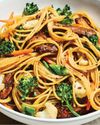
IN THE CARIBBEAN, low-and-slow cooking rooted in the expansive power of smoke is the hallmark of really good barbecue.
That's according to Ramin Ganeshram, journalist, chef, and author of the cookbook Sweet Hands: Island Cooking from Trinidad & Tobago. Smoke carries the aromas of cooking meat and the earthy, warming flavors of allspice. It interlaces with the bright flavors and tender bite of vinegar-marinated escovitch fish; it wraps its arms around friends and families gathering by a fire. The Caribbean is the keeper of one of the world's oldest barbecuing traditions, and smoke has always been at the heart of it.
Most food scholars say that the Taino, an Indigenous people who inhabited various Caribbean islands, including Puerto Rico, Jamaica, Cuba, and the Dominican Republic, were responsible for creating the first documented examples of the cooking technique we now call barbecue. The Taino people had a system: They'd dig a firepit and make a grate of green wood lashed with fibers, says Ganeshram. They started a slow fire in the firepit, placed the meat to be cooked on the wood frame above a slow fire, and called the process barabicu, which means "sacred pit." European colonizers were the first to document some of these traditions, observing Indigenous people slowly cooking fish, vegetables, and iguanas (a delicacy) on raised platforms above smoldering fires. The Taino word barabicu gave rise to the Spanish term barbacoa, which eventually made its way into English as barbecue.
This story is from the July 2023 edition of Food & Wine.
Start your 7-day Magzter GOLD free trial to access thousands of curated premium stories, and 8,500+ magazines and newspapers.
Already a subscriber ? Sign In
This story is from the July 2023 edition of Food & Wine.
Start your 7-day Magzter GOLD free trial to access thousands of curated premium stories, and 8,500+ magazines and newspapers.
Already a subscriber? Sign In

Beef Sukiyaki Pasta
In the hands of cookbook author Hiroko Shimbo, the flavors of beef sukiyaki become an easy weeknight meal.

THE SUMMER PLAYBOOK
25 juicy, cheesy, smushed, shaken, hot-diggity, grill-ready, easy-breezy recipes for the season

Newer Nordic
A cohort of Copenhagen chefs are looking to their Asian roots to reimagine the city's restaurant scene.

33 Stupendous Sauvignon Blancs
Our favorite best-in-class bottles for summer sipping

One-Cup Wonder
Your yogurt container is the key to this simple French cake.

A Sweet Finish
Fruit-based condiments instantly elevate your summer grilling standbys.

How to Burger Better
Upgrade your summer with the best burgers ever.

All in the Family
How chef Tiffany Derry and her family celebrate Mother's Day and Father's Day with a Texas-size feast

Put Some Glamp in Your Camp
Expertly selected items to make your next campout more luxurious

Peak American
New School American cheese is all nostalgia and no nonsense.